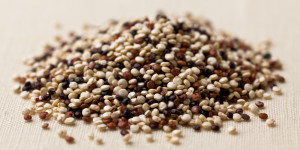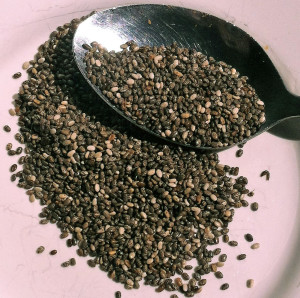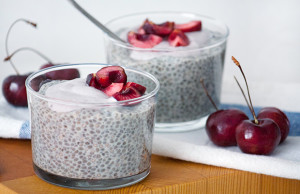Not long ago, I hardly knew about chia seeds or quinoa. I had never eaten chia seeds until a couple of years ago. And quinoa was not the grocery store staple it is today.
How much do we actually know about these super grains and seeds? Some grains and seeds have been a staple food in many diets worldwide and date back thousands of years ago. For instance, quinoa was a staple food for the pre-Columbian civilizations such as the Incas in Peru and Bolivia. Quinoa was called “the mother grain” by the Incas. Chia seeds, on the other hand, are native to Southern Mexico and Central America and were used as a form of currency by the Aztecs.
Beside their popularity in modern diet, these ancient grains and seeds confer excellent health benefits and nutritional value. Here is a guide from five of the most popular ancient grains and seeds:
 #1 Quinoa
#1 Quinoa
Quinoa is considered a whole grain since it has similar nutrient profile of other grains, but it is actually a pseudocereal whose seeds are used like grains. This is a native seed from the Andes area, which dates back more than 5000 years ago. While most quinoa is still grown in South America, due to its popularity, it is now grown in Colorado and California, China, Europe, Canada and India. Quinoa is considered a complete protein because it contains all essential amino acids, including lysine which is rarely found in whole grains. Quinoa contains more protein (12.9% to 16.5%) than barley, oats, rice and maize (corn). It is a gluten-free product, making it attractive for people with celiac disease. It has high carbohydrate content (58.1% to 64.2%); however, it also has a low glycemic index. Quinoa has unique health benefits when compared to other grains. It is rich in iron, magnesium, fiber, vitamin E, calcium, copper and phosphorous. It also contains some B vitamins, potassium and zinc. Moreover, quinoa has almost twice the soluble iron concentration since it contains low levels of phytic acid, also known as phytate. In other grains, higher levels of phytates can interfere with absorption of iron. Quinoa also contains phytosterols. Studies on the effects of phytosterols show that they lower serum cholesterol levels by slowing or reducing the absorption of dietary cholesterol. High nutritional benefits and other properties make this seed a super food. An important cooking tip is to always rinse it well before cooking. Quinoa grows with a bitter coating (saponin) to fend off pests. While most of this coating is removed when it is packed, you should wash quinoa thoroughly to remove any residue before using it.
One cup of cooked quinoa provides 222 calories, 4 grams of total fat, 0 grams of saturated fat and 0 cholesterol, 13 milligrams of sodium, 39 grams of carbohydrate, 5 grams of dietary fiber and 8 grams of protein. It also provides 15% of the daily value (DV) of iron and 3% DV of calcium based on a 2,000 calorie diet.
#2 Amaranth
There are more than 60 different species of amaranthus. Just like quinoa, amaranth is not a true grain but a pseudocereal. However, due to its overall nutritional value, it is also classified as a whole grain. This was an important food crop for the Aztec, Mayan and Incan civilizations. Today, its commercialization is limited. Compared to other grains, amaranth has high protein and dietary fiber content. This grain is not only gluten-free, but it is also high in riboflavin, niacin, ascorbic acid, calcium, magnesium and iron. The lipid content of amaranth is very important, constituting great variation such as palmitic, oleic, linoleic and linolenic acid. It also contains tocopherols, which have vitamin E and antioxidant properties. Animal studies have reported that amaranth consumption had a cholesterol lowering effect by reducing total cholesterol by 50%. Cooking amaranth is very simple; however, this grain absorbs a lot of water. According to the wholegrainscouncil.com, it is recommended to use six cups of water per one cup of amaranth.
According to the USDA, one cup of cooked amaranth contains 251 calories, 4 grams of total fat, 0 saturated fat and 0 cholesterol, 15 milligrams of sodium, 46 grams of carbohydrate, 5 grams of dietary fiber and 9 grams of protein. It also provides 29% DV of iron and 12 % DV of calcium (based on a 2,000-calorie diet).
#3 Teff
A member of the genus Eragrostis, teff is the tiniest grain in the world. Teff has been cultivated and utilized as primary food in Africa for thousands of years. Teff is gluten-free. It has more calcium, zinc, iron and potassium and is higher in fiber than other cereals such as wheat, barley and rice. A study of Ethiopian foods revealed that teff was a good source of dietary polyphenols: these are considered natural antioxidants which have health benefits and are associated with lower disease risk.
One cup of cooked teff provides 255 calories, 2 grams of total fat, 0 grams of saturated fat and cholesterol, 50 grams of carbohydrates and 10 grams of protein.
 #4 Chia Seeds
#4 Chia Seeds
These seeds come from salvia hispanica L., a plant from the mint family that can be cultivated twice a year. . Chia seeds contain from 25% to 40% oil, of which 60% is omega-3 and 20% is omega-6 fatty acids. These are essential fatty acids which must be consumed in our diet since our body does not make them. Other nutritional properties of this seed are that it contains protein (15-25%), fats (30-35%), carbohydrates (26-41%) and dietary fiber (18-30%). It also contains high amount of antioxidants. Recently, chia seeds have gained popularity due to the high content of polyunsaturated fatty acids (PUFA) and omega 3 (ALA). Furthermore, there is a high association with the consumption of PUFAS and lower risks for cardiovascular diseases. However, the US Dietary Guidelines recommended limiting chia consumption to no more than 48g per day. Current research indicates that chia seeds are a good choice for healthy oils, which can help to maintain a healthy lipid profile. However, the number of clinical studies in the consumption of chia seeds is still limited at this time.
One ounce of dried chia seeds provides 137 calories, 9 grams of total fat, 1 gram of saturated fat, 0 grams of cholesterol, 5 milligrams of sodium, 12 grams of carbohydrate, 11 grams of dietary fiber and 4 grams of protein.
#5 Flax Seed
This tiny nutritious seed, which comes from flax, has a long history. Flax seeds have been known since the Stone Ages, but the first culinary records date back to ancient Greece. This seed has gained popularity in our diets due to its high content of essential polyunsaturated fatty acids (PUFAS), which have a protective effect against atherosclerosis. Flax seeds have high nutritional value; they are a rich source of B vitamins, magnesium, manganese, fiber and omega-3 fatty acids. The possible health benefits of consuming this seed are quite extensive, including a protective effect against cancer, lowering cholesterol and improving blood sugar. Furthermore, research indicates that consumption of flaxseeds may lower blood pressure slightly: more benefits were observed when this was consumed as a whole seed and for more than 12 weeks.
Two tablespoons of ground flax seed contain 60 calories, 5 grams of total fat, 1 gram of saturated fat and 0 grams of cholesterol, 4 grams of carbohydrate, 4 grams of dietary fiber and 3 grams of protein.
Try Some Healthy & Delicious Recipes:
 Ancient grains and seeds can be a welcome addition to your meals. If you’ve never tried them before, here are a few recipes to get you started.
Ancient grains and seeds can be a welcome addition to your meals. If you’ve never tried them before, here are a few recipes to get you started.
- Lemony Quinoa Salad with Shaved Vegetables
- Popped Amaranth Crunch
- Banana Bread with Teff and Chocolate
- Cherry Chia Seed Pudding
- Garlic Parmesan Flax Seed Crackers
References:
- The Food Navigator-USA.com.10 Ancient grains to watch: from Kamut to quinoa. Accessed on August 17, 2015. Available at: http://www.foodnavigator-usa.com/Markets/10-ancient-grains-to-watch-from-kamut-to-quinoa
- Kenyon Chelsie. Chia Seeds. Mexican Food.about.com. Accessed on August 17, 2015. Available at: http://mexicanfood.about.com/od/history/a/Chia-Seeds.htm
- James A. and Lilian E. Quinoa (Chenopodium quinoa Willd.): Composition, Chemistry, Nutritional and Functional Properties. Advances in Food and Nutrition Research. 2009;58:1-25. doi:10.1016/S1043-4526(09)58001-1
- Graf BL, Rojas-Siva P, Rojo LE, Delatorre-Herrera J, Balderon ME, and Raskin I. Innovations in Health Value and Functional Food Development of Quinoa (Chenopodium quinoa Willd.). Institute of Food Technologists. Comprehensive Reviews in Food Science and Food Safety. 2015(14):431-445. doi: 10.1111/1541-4337.12135
- Venskutonis PR and Krajalis P. Nutritional Components of Amaranth seeds and Vegetables: A Review on Composition, Properties, and Uses. Institute of Food Technologists. Comprehensive Reviews in Food Science and Food Safety. 2013(12):381-412. doi:10.1111/1541-4337.12021
- The Whole Grain Council. Quinoa March Grain of the Month. Accessed on August 18, 2015. Available at: http://wholegrainscouncil.org/whole-grains-101/quinoa-march-grain-of-the-month
- com. Nutrition Facts of Amaranth. Accessed on August 18, 2015. Available at: http://nutritiondata.self.com/facts/cereal-grains-and-pasta/10640/2
- Caselato-Sousa VM and Amaya-Farfan J. State of Knowledge on Amaranth Grain: A comprehensive Review. Journal of Food Science. 2012(77):93-104. doi:10.1111/j.1750-3841.2012.02645.x
- Norlaily Mohd Ali et al. The Promising Future of Chia, Salvia hispanica L. Journal of Biomedicine and Biotechnology. 2012:1-9. doi:10.1155/2012/171956

